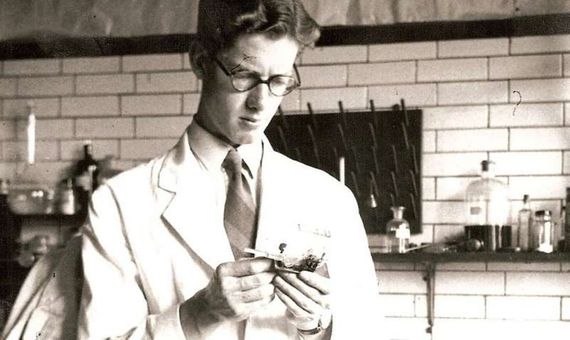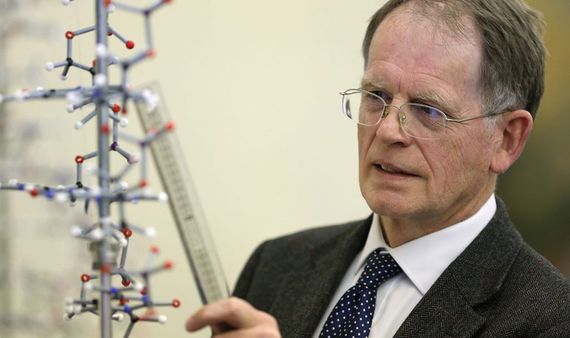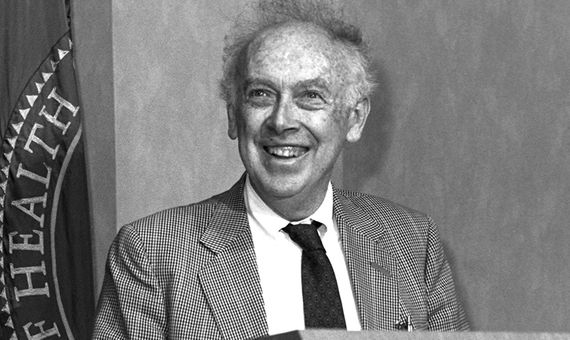Since the discovery of the structure of DNA by James Watson and Francis Crick in 1953, enough has been written to understand that the achievement was not solely that of a dynamic duo. Science advances on the shoulders of giants, and some of those who lent theirs to make one of the fundamental discoveries of the 20th century a reality have gone almost unnoticed. One of them was James Michael Creeth, a British biochemist whose name would perhaps be recognised worldwide today if bad luck and academic prejudices had not allied against him.
In the 1940s, a race was underway to learn the structure of DNA, once it began to be suspected that it was in this molecule, and not in proteins, where genes resided. Among the contenders were chemists John Masson Gulland and Denis Oswald Jordan, both from the University College of Nottingham (United Kingdom). Under their direction, in 1947, doctoral students C. J. Threlfall and H.F.W. Taylor succeeded in, respectively, isolating high purity DNA from the calf thymus—an organ of the immune system—and studying its response to acidic or alkaline conditions.

By then it was known that DNA was made up of phosphate, deoxyribose (a sugar) and four types of nitrogenous bases (adenine, guanine, cytosine and thymine). Together, these three elements constitute a nucleotide. The challenge was to solve the puzzle so that the nucleotides built a stable and versatile structure.
For this, the scientists submitted the molecules to titration experiments, consisting of measuring the pH change (acidity) of the sample as an acid or alkali was added. However, the DNA did not respond as was expected from its components. Gulland and Jordan intuited that this strange behaviour was due to the fact that the titrable chemical groups of the nitrogenous bases were hidden and inaccessible inside the molecule.
The crucial experiment
It was then that a third doctoral student, 23-year-old Creeth, provided the crucial experiment and an interpretation that would be surprisingly accurate. Creeth (3 October 1924 – 15 January 2010) measured the viscosity of the DNA during the titration experiments, observing that the molecule became more fluid under strong acid or alkaline conditions, and that only then did the chemical groups of the nitrogenous bases respond to the variation of the acidity of the medium.

The study, published in 1947, helped Creeth to propose that same year in his doctoral thesis that the nitrogenous bases were paired two to two inside the DNA molecule, whose backbone left sugar and phosphate outside. The strong acids or alkalis broke the bonds between the bases, formed by a link called the hydrogen bridge, so that this break exposed their groups and disintegrated the molecule reducing its viscosity.
A model ahead of its time
Creeth drew a model of DNA composed not of a continuous double chain, but of overlapping fragments like two rows of bricks. At that time it was impossible to deduce the helically coiled structure, since the X-ray images that Rosalind Franklin and Raymond Gosling would obtain in 1952 were not yet available. Otherwise, Creeth’s model was correct and ahead of its time; even five years later, the American Linus Pauling proposed an erroneous structure consisting of three chains with the bases exposed and the sugar and phosphate in the interior.

In fact, Watson would recognise in his book The Double Helix that Creeth’s work inspired him to conceive the structure of DNA just one week later. However, only the study published by Franklin and Gosling made reference to the Nottingham group, a team that, sadly, would soon dissolve for various vicissitudes: Gulland died in 1947 in a train accident and Jordan emigrated to Australia. When Creeth applied for a post-doctorate position at Cambridge, he was denied because this elite university only recognized the doctorates of certain institutions, and the University College of Nottingham was not among them. Instead, Creeth was offered a second doctorate, which he declined.
Six years later, Watson and Crick would go down in history—from Cambridge. Had Creeth been admitted there, perhaps he would have been part of that story. Instead, he emigrated to the US and devoted the rest of his career, ironically, to the structure of proteins. Since his death in 2010, virtually ignored, the biochemist Stephen Harding and other scientists at the University of Nottingham have been waging a battle against obscurity so that the name of Creeth finally occupies the place it deserves.
Comments on this publication